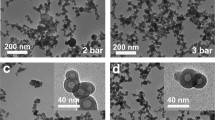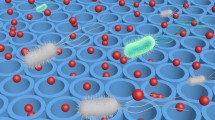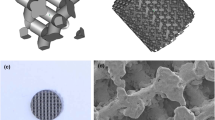Abstract
3D-printed Porous Titanium Alloy Implants (pTi), owing to their biologically inertness and relatively smooth surface morphology, adversely affect the biological functions of surrounding cells. To address the challenges, constructing a bioinspired interface that mimics the hierarchical structure of bone tissue can enhance the cellular functions of cells. In this context, Hollow Mesoporous Silica Nanoparticles (HMSNs), renowned for their unique physicochemical properties and superior biocompatibility, offer a promising direction for this research. In this research, the initially synthesized HMSNs were used to construct a “hollow-mesoporous-macroporous” hierarchical bioinspired coating on the pTi surface through the Layer-by-Layer technique. Simultaneously, diverse morphologies of coatings were established by adjusting the deposition strategy of PDDA/HMSNs on the pTi surface (pTi-HMSN-2, pTi-HMSN-4, pTi-HMSN-6). A range of techniques were employed to investigate the physicochemical properties and regulation of cellular biological functions of the diverse HMSN coating strategies. Notably, the pTi-HMSN-4 and pTi-HMSN-6 groups exhibited the uniform coatings, leading to a substantial enhancement in surface roughness and hydrophilicity. Meantime, the coating constructed strategy of pTi-HMSN-4 possessed commendable stability. Based on the aforementioned findings, both pTi-HMSN-4 and pTi-HMSN-6 facilitated the adhesion, spreading, and pseudopodia extension of BMSCs, which led to a notable upsurge in the expression levels of vinculin protein in BMSCs. Comprehensive analysis indicates that the coating, when PDDA/HMSNs are deposited four times, possesses favorable overall performance. The research will provide a solid theoretical basis for the translation of HMSN bioinspired coatings for orthopedic implants.









Similar content being viewed by others
Data Availability
Data will be made available on request.
References
Yang, Z., Xi, Y., Bai, J., Jiang, Z., Wang, S., Zhang, H., Dai, W., Chen, C., Gou, Z., Yang, G., & Gao, C. (2021). Covalent grafting of hyperbranched poly-L-lysine on Ti-based implants achieves dual functions of antibacteria and promoted osteointegration in vivo. Biomaterials, 269, 120534. https://doi.org/10.1016/j.biomaterials.2020.120534.
Guillem-Marti, J., Vidal, E., Girotti, A., Heras-Parets, A., Torres, D., Arias, F. J., Ginebra, M., Rodriguez-Cabello, J., & Manero, J. M. (2023). Functionalization of 3D-Printed titanium scaffolds with elastin-like recombinamers to improve cell colonization and osteoinduction. Pharmaceutics, 15(3), 872. https://doi.org/10.3390/pharmaceutics15030872.
Ma, D., Wang, J., Zheng, M., Zhang, Y., Huang, J., Li, W., Ding, Y., Zhang, Y., Zhu, S., Wu, X., & Guan, S. (2023). Degradation behavior of ZE21C magnesium alloy suture anchors and their effect on ligament-bone junction repair. Bioactive Materials, 26, 128–141. https://doi.org/10.1016/j.bioactmat.2023.02.021.
Ma, Z., Liu, B., Li, S., Wang, X., Li, J., Yang, J., Tian, S., Wu, C., & Zhao, D. (2023). A novel biomimetic trabecular bone metal plate for bone repair and osseointegration. Regenerative Biomaterials, 10, rbad003. https://doi.org/10.1093/rb/rbad003.
Raucci, M. G., D’Amora, U., Ronca, A., Demitri, C., & Ambrosio, L. (2019). Bioactivation routes of gelatin-based scaffolds to enhance at nanoscale level bone tissue regeneration. Frontiers in Bioengineering and Biotechnology, 7, 27. https://doi.org/10.3389/fbioe.2019.00027.
Bai, H., Zhao, Y., Wang, C., Wang, Z., Wang, J., Liu, H., Feng, Y., Lin, Q., Li, Z., & Liu, H. (2020). Enhanced osseointegration of three-dimensional supramolecular bioactive interface through osteoporotic microenvironment regulation. Theranostics, 10(11), 4779. https://doi.org/10.7150/thno.43736.
Wegst, U., Bai, H., Saiz, E., Tomsia, A., & Ritchie, R. (2015). Bioinspired structural materials. Nature Materials, 14(1), 23–36. https://doi.org/10.1038/nmat4089.
Xu, C., Chen, X., Wu, W., Liu, Q., & Ren, L. (2022). Bioinspired multi-metal structures produced via direct ink writing. Journal of Bionic Engineering, 19(6), 1578–1588. https://doi.org/10.1007/s42235-022-00257-2.
Zhang, J., Bai, H., Bai, M., Wang, X., Li, Z., Xue, H., Wang, J., Cui, Y., Wang, H., Wang, Y., Zhou, R., Zhu, X., Xu, M., & Liu, H. (2023). Bisphosphonate-incorporated coatings for orthopedic implants functionalization. Materials Today Bio, 22, 100737. https://doi.org/10.1016/j.mtbio.2023.100737.
Xu, J., Xu, N., Zhou, T., Xiao, X., Gao, B., Fu, J., & Zhang, T. (2017). Polydopamine coatings embedded with silver nanoparticles on nanostructured titania for long-lasting antibacterial effect. Surface and Coatings Technology, 320, 608–613.
Sadeghi, M., Kharaziha, M., & Salimijazi, H. R. (2019). Double layer graphene oxide-PVP coatings on the textured Ti6Al4V for improvement of frictional and biological behavior. Surface and Coatings Technology, 374, 656–665. https://doi.org/10.1016/j.surfcoat.2019.06.048.
Zhou, C., Luo, C., Liu, S., Jiang, S., Liu, X., Li, J., Zhang, X., Wu, X., Sun, J., & Wang, Z. (2022). Pearl-inspired graphene oxide-collagen microgel with multi-layer mineralization through microarray chips for bone defect repair. Materials Today Bio, 15, 100307. https://doi.org/10.1016/j.mtbio.2022.100307.
Qiao, X., Yang, J., Shang, Y., Deng, S., Yao, S., Wang, Z., Guo, Y., & Peng, C. (2020). Magnesium-doped nanostructured titanium surface modulates macrophage-mediated inflammatory response for ameliorative osseointegration. International Journal of Nanomedicine, 15, 7185–7198. https://doi.org/10.2147/ijn.s239550.
Shen, X., Hu, Y., Xu, G., Chen, W., Xu, K., Ran, Q., Ma, P., Zhang, Y., Li, J., & Cai, K. (2014). Regulation of the biological functions of osteoblasts and bone formation by Zn-incorporated coating on microrough titanium. ACS Applied Materials & Interfaces, 6(18), 16426–16440. https://doi.org/10.1021/am5049338.
Zhou, P., Li, H., Mao, F., Huang, H., Long, S., He, F., Chen, J., & Wei, S. (2021). Screening the optimal patterned surfaces consisting of cell morphology mimicking micro-pillars and nanotube arrays for the design of titanium implants. Journal of Bionic Engineering, 18, 361–374. https://doi.org/10.1007/s42235-021-0019-x.
Huo, K., Zhang, X., Wang, H., Zhao, L., Liu, X., & Chu, P. K. (2013). Osteogenic activity and antibacterial effects on titanium surfaces modified with Zn-incorporated nanotube arrays. Biomaterials, 34(13), 3467–3478. https://doi.org/10.1016/j.biomaterials.2013.01.071.
Yan, Y., Wei, Y., Yang, R., Xia, L., Zhao, C., Gao, B., Zhang, X., Fu, J., Wang, Q., & Xu, N. (2019). Enhanced osteogenic differentiation of bone mesenchymal stem cells on magnesium-incorporated titania nanotube arrays. Colloids and Surfaces B: Biointerfaces, 179, 309–316. https://doi.org/10.1016/j.colsurfb.2019.04.013.
Alvarez echazú, M. I., Renou, S. J., Alvarez, G. S., Desimone, M. F., & Olmedo, D. (2022). Synthesis and evaluation of a chitosan–silica-based bone substitute for tissue engineering. International Journal of Molecular Sciences, 23(21), 13379. https://doi.org/10.3390/ijms232113379.
Li, Z., He, Y., Klausen, L. H., Yan, N., Liu, J., Chen, F., Wen, S., Dong, M., & Zhang, Y. (2021). Growing vertical aligned mesoporous silica thin film on nanoporous substrate for enhanced degradation, drug delivery and bioactivity. Bioactive Materials, 6(5), 1452–1463. https://doi.org/10.1016/j.bioactmat.2020.10.026.
Huang, L., Zhang, Q., Dai, L., Shen, X., Chen, W., & Cai, K. (2017). Phenylboronic acid-modified hollow silica nanoparticles for dual-responsive delivery of doxorubicin for targeted tumor therapy. Regenerative Biomaterials, 4(2), 111–124. https://doi.org/10.1093/rb/rbw045.
Mura, S., Nicolas, J., & Couvreur, P. (2013). Stimuli-responsive nanocarriers for drug delivery. Nature Materials, 12(11), 991–1003. https://doi.org/10.1038/nmat3776.
Wu, D., Zhu, Z. Q., Tang, H. X., Shi, Z. E., Kang, J., Liu, Q., & Qi, J. (2020). Efficacy-shaping nanomedicine by loading calcium peroxide into tumor microenvironment-responsive nanoparticles for the antitumor therapy of prostate cancer. Theranostics, 10(21), 9808. https://doi.org/10.7150/thno.43631.
Jin, T., Wu, D., Liu, X., Xu, J., Ma, B. J., Ji, Y., Jin, Y., Wu, S., Wu, T., & Ma, K. (2020). Intra-articular delivery of celastrol by hollow mesoporous silica nanoparticles for pH-sensitive anti-inflammatory therapy against knee osteoarthritis. Journal of Nanobiotechnology, 18(94), 1–15. https://doi.org/10.1186/s12951-020-00651-0.
Langmuir, I. (1920). The mechanism of the surface phenomena of flotation. Transactions of the Faraday Society, 15, 62–74. https://doi.org/10.1039/tf9201500062.
Sagiv, J. (1980). Organized monolayers by adsorption. 1. Formation and structure of oleophobic mixed monolayers on solid surfaces. Journal of the American Chemical Society, 102(1), 92–98. https://doi.org/10.1021/ja00521a016.
Lopes, M., Abrahim, B., Veiga, F., Seiça, R., Cabral, L. M., Arnaud, P., Andrade, J. C., & Ribeiro, A. J. (2017). Preparation methods and applications behind alginate-based particles. Expert Opinion on Drug Delivery, 14(6), 769–782. https://doi.org/10.1080/17425247.2016.1214564.
Täuber, K., Zhao, Q., Antonietti, M., & Yuan, J. (2015). Tuning the pore size in gradient poly (ionic liquid) membranes by small organic acids. ACS Macro Letters, 4(1), 39–42. https://doi.org/10.1021/mz500674d.
Yang, G. L., He, F. M., Yang, X. F., Wang, X. X., & Zhao, S. F. (2009). In vivo evaluation of bone-bonding ability of RGD‐coated porous implant using layer‐by‐layer electrostatic self‐assembly. Journal of Biomedical Materials Research Part A, 90(1), 175–185. https://doi.org/10.1002/jbm.a.32055.
Li, B., Jiang, B., Boyce, B. M., & Lindsey, B. A. (2009). Multilayer polypeptide nanoscale coatings incorporating IL-12 for the prevention of biomedical device-associated infections. Biomaterials, 30(13), 2552–2558. https://doi.org/10.1016/j.biomaterials.2009.01.042.
Liu, H., Ding, J., Wang, C., Wang, J., Wang, Y., Yang, M., Jia, Y., Zhang, Y., Chang, F., Li, R., & Chen, X. (2015). Intra-articular transplantation of allogeneic BMMSCs rehabilitates cartilage injury of antigen-induced arthritis. Tissue Engineering Part A, 21(21–22), 2733–2743. https://doi.org/10.1089/ten.tea.2014.0666.
Shao, M., Chang, C., Liu, Z., Chen, K., Zhou, Y., Zheng, G., Huang, Z., Xu, H., Xu, P., & Lu, B. (2019). Polydopamine coated hollow mesoporous silica nanoparticles as pH-sensitive nanocarriers for overcoming multidrug resistance. Colloids and Surfaces B: Biointerfaces, 183, 110427. https://doi.org/10.1016/j.colsurfb.2019.110427.
Fu, J., Li, T., Yang, Y., Jiang, L., Wang, W., Fu, L., Zhu, Y., & Hao, Y. (2021). Activatable nanomedicine for overcoming hypoxia-induced resistance to chemotherapy and inhibiting tumor growth by inducing collaborative apoptosis and ferroptosis in solid tumors. Biomaterials, 268, 120537. https://doi.org/10.1016/j.biomaterials.2020.120537.
Geng, H., Zhao, Y., Liu, J., Cui, Y., Wang, Y., Zhao, Q., & Wang, S. (2016). Hollow mesoporous silica as a high drug loading carrier for regulation insoluble drug release. International Journal of Pharmaceutics, 510(1), 184–194. https://doi.org/10.1016/j.ijpharm.2016.05.067.
Nasiri, N., Mukherjee, S., Panneerselvan, A., Nisbet, D. R., & Tricoli, A. (2018). Optimally hierarchical nanostructured hydroxyapatite coatings for superior prosthesis biointegration. ACS Applied Materials Interfaces, 10(29), 24840–24849. https://doi.org/10.1021/acsami.8b08029.
Yang, W., Han, Q., Chen, H., Li, Y., Guo, X., Zhang, A., Liu, Y., Sun, Y., & Wang, J. (2024). Additive manufactured trabecular-like Ti-6Al-4V scaffolds for promoting bone regeneration. Journal of Materials Science & Technology, 188, 116–130. https://doi.org/10.1016/j.jmst.2023.10.061.
Smith, R., Moule, M., Sule, P., Smith, T., Cirillo, J. D., & Grunlan, J. C. (2017). Polyelectrolyte multilayer nanocoating dramatically reduces bacterial adhesion to polyester fabric. ACS Biomaterials Science Engineering, 3(8), 1845–1852. https://doi.org/10.1021/acsbiomaterials.7b00250.
Hao, Y., Li, S., Han, X., Hao, Y., & Ai, H. (2013). Effects of the surface characteristics of nanoporous titanium oxide films on Ti-24Nb-4Zr-8Sn alloy on the initial adhesion of osteoblast-like MG-63 cells. Experimental and Therapeutic Medicine, 6(1), 241–247. https://doi.org/10.3892/etm.2013.1104.
Ranganathan, S. I., Yoon, D. M., Henslee, A. M., Nair, M. B., Smid, C., Kasper, F. K., & Ferrari, M. (2010). Shaping the micromechanical behavior of multi-phase composites for bone tissue engineering. Acta Biomaterialia, 6(9), 3448–3456. https://doi.org/10.1016/j.actbio.2010.03.029.
Li, X., Wang, M., Zhang, W., Bai, Y., Liu, Y., Meng, J., & Zhang, L. (2020). A magnesium-incorporated nanoporous titanium coating for rapid osseointegration. International Journal of Nanomedicine, 15, 6593–6603. https://doi.org/10.2147/ijn.s255486.
Liu, C., Zhang, J., Zhao, X., Xu, M., Liu, H., & Zhou, H. (2023). Stability, biomechanics and biocompatibility analysis following different preparation strategies of hierarchical zeolite coatings on titanium alloy surfaces. Frontiers in Bioengineering and Biotechnology, 11, 1337709. https://doi.org/10.3389/fbioe.2023.1337709.
Hida, M., Miyazawa, K., Tsuruta, S., Kurosawa, M., Hata, Y., Kawai, T., & Goto, S. (2013). Effect of heat treatment conditions on the mechanical properties of Ti-6Mo-4Sn alloy for orthodontic wires. Dental Materials Journal, 32(3), 462–467. https://doi.org/10.4012/dmj.2012-118.
Goodarzi, H., Jadidi, K., Pourmotabed, S., Sharifi, E., & Aghamollaei, H. (2018). Preparation and in vitro characterization of cross-linked collagen-gelatin hydrogel using EDC/NHS for corneal tissue engineering applications. International Journal of Biological Macromolecules, 126, 620–632. https://doi.org/10.1016/j.ijbiomac.2018.12.125.
Gong, T., Xie, J., Liao, J., Zhang, T., Lin, S., & Lin, Y. (2015). Nanomaterials and bone regeneration. Bone Research, 3(1), 1–7. https://doi.org/10.1038/boneres.2015.29.
Liu, S., Liu, T., Chen, J., Maitz, M., Chen, C., & Huang, N. (2013). Influence of a layer-by‐layer‐assembled multilayer of anti‐CD34 antibody, vascular endothelial growth factor, and heparin on the endothelialization and anticoagulation of titanium surface. Journal of Biomedical Materials Research Part A, 101(4), 1144–1157. https://doi.org/10.1002/jbm.a.34392.
Xiong, S., Lu, X., Zuo, R., Huang, P., & Yang, B. (2022). Regulation of the macrophage phenotype on titanium metal by surface modification. Journal of Bionic Engineering, 19(6), 1625–1636. https://doi.org/10.1007/s42235-022-00242-9.
Ma, D., Zhang, K., Dong, B., She, J., & Zhang, Y. (2023). Study of hydroxyapatite-coated high-strength biodegradable magnesium-based alloy in repairing fracture damage in rats. in vivo, 37(1), 190–203. https://doi.org/10.21873/invivo.13068.
Ding, Z., Wang, Y., Zhou, Q., Ding, Z., Liu, J., He, Q., & Zhang, H. (2019). Microstructure, wettability, corrosion resistance and antibacterial property of Cu-MTa2O5 multilayer composite coatings with different cu incorporation contents. Biomolecules, 10(1), 68. https://doi.org/10.3390/biom10010068.
Vereschaka, A., Grigoriev, S., Chigarev, A., Milovich, F., Sitnikov, N., Andreev, N., & Bublikov, J. (2021). Development of a model of crack propagation in multilayer hard coatings under conditions of stochastic force impact. Materials, 14(2), 260. https://doi.org/10.3390/ma14020260.
Zhao, R., Zhang, X., Chen, F., Man, X., & Jiang, W. (2019). Study on electrochemical degradation of nicosulfuron by IrO2-based DSA electrodes: Performance, kinetics, and degradation mechanism. International Journal of Environmental Research and Public Health, 16(3), 343. https://doi.org/10.3390/ijerph16030343.
Zhu, W. D., Liu, Q. B., Zheng, M., & Wang, X. D. (2008). Biocompatibility of a functionally graded bioceramic coating made by wide-band laser cladding. Journal of Biomedical Materials Research Part A, 87(2), 429–433. https://doi.org/10.1002/jbm.a.31774.
Krishna, B. V., Xue, W., Bose, S., & Bandyopadhyay, A. (2008). Functionally graded Co–Cr–Mo coating on Ti–6Al–4V alloy structures. Acta Biomaterialia, 4(3), 697–706. https://doi.org/10.1016/j.actbio.2007.10.005.
Li, H. C., Wang, D. G., Hu, C., Dou, J. H., Yu, H. J., & Chen, C. Z. (2021). Effect of Na2O and ZnO on the microstructure and properties of laser cladding derived CaO-SiO2 ceramic coatings on titanium alloys. Journal of Colloid and Interface Science, 592, 498–508. https://doi.org/10.1016/j.jcis.2021.02.064.
Lu, Z., Wang, J., Qu, L., Kan, G., Zhang, T., Shen, J., Li, Y., Yang, J., Niu, Y., Xiao, Z., Li, Y., & Zhang, X. (2020). Reactive mesoporous silica nanoparticles loaded with limonene for improving physical and mental health of mice at simulated microgravity condition. Bioactive Materials, 5(4), 1127–1137. https://doi.org/10.1016/j.bioactmat.2020.07.006.
Menon, N., & Leong, D. (2016). Cytotoxic effects of phosphonate-functionalized mesoporous silica nanoparticles. ACS Applied Materials Interfaces, 8(3), 2416–2422. https://doi.org/10.1016/j.ijpharm.2021.121079.
Zhao, J., Bu, D., Zhang, N., Zhang, N., Tian, D. N., Ma, L. Y., & Yang, H. F. (2021). Cytotoxicity of mesoporous silica modified by amino and carboxyl groups on vascular endothelial cells. Environmental Toxicology, 36(7), 1422–1433. https://doi.org/10.1002/tox.23138.
Liu, T., Li, L., Teng, X., Huang, X., Liu, H., Chen, D., Ren, J., & He, J. (2011). Tang F. single and repeated dose toxicity of mesoporous hollow silica nanoparticles in intravenously exposed mice. Biomaterials, 32(6), 1657–1668. https://doi.org/10.1016/j.biomaterials.2010.10.035.
Cui, H., Wang, Y., Cui, L., Zhang, P., Wang, X., Wei, Y., & Chen, X. (2014). In vitro studies on regulation of osteogenic activities by electrical stimulus on biodegradable electroactive polyelectrolyte multilayers. Biomacromolecules, 15(8), 3146–3157. https://doi.org/10.1021/bm5007695.
Wu, J., Chen, T., Wang, Z., Chen, X., Qu, S., Weng, J., Zhi, W., & Wang, J. (2020). Joint construction of micro-vibration stimulation and BCP scaffolds for enhanced bioactivity and self-adaptability tissue engineered bone grafts. Journal of Materials Chemistry B, 8(19), 4278–4288. https://doi.org/10.1039/d0tb00223b.
Park, J., Bauer, S., von der Mark, K., & Schmuki, P. (2007). Nanosize and vitality: TiO2 nanotube diameter directs cell fate. Nano Letters, 7(6), 1686–1691. https://doi.org/10.1021/nl070678d.
Oh, S., Brammer, K. S., Li, Y. J., Teng, D., Engler, A. J., Chien, S., & Jin, S. (2009). Stem cell fate dictated solely by altered nanotube dimension. Proceedings of the National Academy of Sciences, 106(7), 2130–2135. https://doi.org/10.1073/pnas.0813200106.
Hu, K., Ji, L., Applegate, K. T., Danuser, G., & Waterman-Storer, C. M. (2007). Differential transmission of actin motion within focal adhesions. Science, 315(5808), 111–115. https://doi.org/10.1126/science.1135085.
Vandrovcova, M., Hanus, J., Drabik, M., Kylian, O., Biederman, H., Lisa, V., & Bacakova, L. (2012). Effect of different surface nanoroughness of titanium dioxide films on the growth of human osteoblast-like MG63 cells. Journal of Biomedical Materials Research Part A, 100(4), 1016–1032. https://doi.org/10.1002/jbm.a.34047.
Auernheimer, V., Lautscham, L. A., Leidenberger, M., Friedrich, O., Kappes, B., Fabry, B., & Goldmann, W. H. (2015). Vinculin phosphorylation at residues Y100 and Y1065 is required for cellular force transmission. Journal of Cell Science, 128(18), 3435–3443. https://doi.org/10.1242/jcs.172031.
Acknowledgements
This work was financially supported by the National Natural Science Foundation of China (Grant No. 82372391, 82001971, 82102358, 82202698, 52105343, U21A2099 and U23A20523); Project of “Medical + X” interdisciplinary innovation team of Norman Bethune Health Science Center of Jilin University (Grant No. 2022JBGS06); Project of youth interdisciplinary innovation team of Jilin University (Grant No. 419070623054); China Postdoctoral Science Foundation (Grant No. 2021M701384); Bethune Plan of Jilin University (Grant No. 2022B27, 2022B03); Wu Jieping Medical Foundation (Grant No. 320.6750.18522); Scientific Development Program of Jilin Province (Grant No. 20220402067GH); Jilin Province Development and Reform Commission (Grant No. 2022C044-2).
Author information
Authors and Affiliations
Corresponding authors
Ethics declarations
Competing interests
The authors declare that the research was conducted in the absence of any comer-cial or financial relationships that could be construed as a potential conflict of interest.
Additional information
Publisher’s Note
Springer Nature remains neutral with regard to jurisdictional claims in published maps and institutional affiliations.
Electronic Supplementary Material
Below is the link to the electronic supplementary material.
Rights and permissions
Springer Nature or its licensor (e.g. a society or other partner) holds exclusive rights to this article under a publishing agreement with the author(s) or other rightsholder(s); author self-archiving of the accepted manuscript version of this article is solely governed by the terms of such publishing agreement and applicable law.
About this article
Cite this article
Zhang, J., Liu, H., Wang, J. et al. Bioinspired Hollow Mesoporous Silica Nanoparticles Coating on Titanium Alloy with Hierarchical Structure for Modulating Cellular Functions. J Bionic Eng (2024). https://doi.org/10.1007/s42235-024-00511-9
Received:
Revised:
Accepted:
Published:
DOI: https://doi.org/10.1007/s42235-024-00511-9




